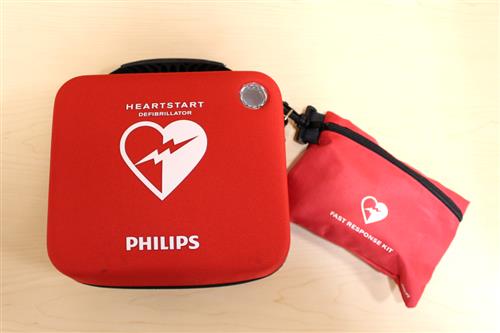 Amy Moran never thought she would see her 40th birthday.
Amy Moran never thought she would see her 40th birthday.
At 20, the Kickapoo High School counselor was diagnosed with hypertrophic cardiomyopathy (HCM), the No. 1 cause of sudden deaths.
A pacemaker was placed in her heart at 21, and at 28, she gave birth to a baby boy, Brendan. But her heart disease caused her second pregnancy to have complications, and she coded three times while giving birth.
“My little boy Dylan is 9, and in the past eight years, I’ve had two open heart surgeries,” she said. “Heart disease a huge part of my life. So I was ecstatic and so happy to hear that AEDs were coming to our buildings. As I’ve been here over the 13 years, SPS has become more proactive with heart disease.”
In the spirit of of American Heart Month, SPS will begin in late February deploying automated external defibrillators across the district. A total of 110 devices will be installed in obvious, highly visible locations, with at least one AED at every SPS site. The effort reflects the district’s commitment to equipping facilities to respond to a cardiac event, said Jean Grabeel, director of health services.
“We purchased the fully automated versions of the AED, which are designed for anyone to use,” she said. “It provides step by step visual and verbal directions. So a student can use it, an employee can use it, or anyone in the public as well. So if we have an event that’s going on in one of our gyms, maybe a basketball game, and a spectator collapses, anyone can get that AED and begin to assist as someone does CPR.”
Currently, more than 600 SPS employees are trained in CPR, with the number gaining every year. CPR instructor and Shining Stars Early Childhood Education Center school nurse Rene’e Deason conducted seven CPR training classes last July.
But for Deason, it’s not about the skills the class provides, it’s also the confidence it gives attendees in performing CPR and using an AED, she says.
“For the last couple of years in our CPR training, staff have been trained on using the AED as well,” she said. “When you think about our students, it’s frightening to think you might have to use it. But having that added tool that we can have to access, instead of waiting for someone to arrive, adds a bit of confidence in helping meet the needs of our students and staff.”
In addition to the installation of the AEDs districtwide, school nurses like Deason will team up with Health Services to provide on-site training on where the AED is, how to use it and what to do in a cardiac event.
“Time is critical in any cardiac event,” said Jeff Rogers, wellness coordinator. “Having trained staff and AED equipment onsite will only increase an individual’s chances of survival.”
Moran’s oldest son, Brendan, is now an active sixth-grader at Pershing K-8 School. He’s 11 years old, and he has the gene that causes her heart disease, which could appear during his adolescence. And while he gets tested every year, the AED means so much to her as a parent, Moran says.
“It’s always in mind that he’s going to get the disease and that he’ll be in PE class, because he’s very active and he loves sports, and you never know,” she says. “So I’m so relieved not just for the students and staff, but also for my own children. An AED could save some child’s life. And for that one child, for that one parent, it could make all the difference.”

